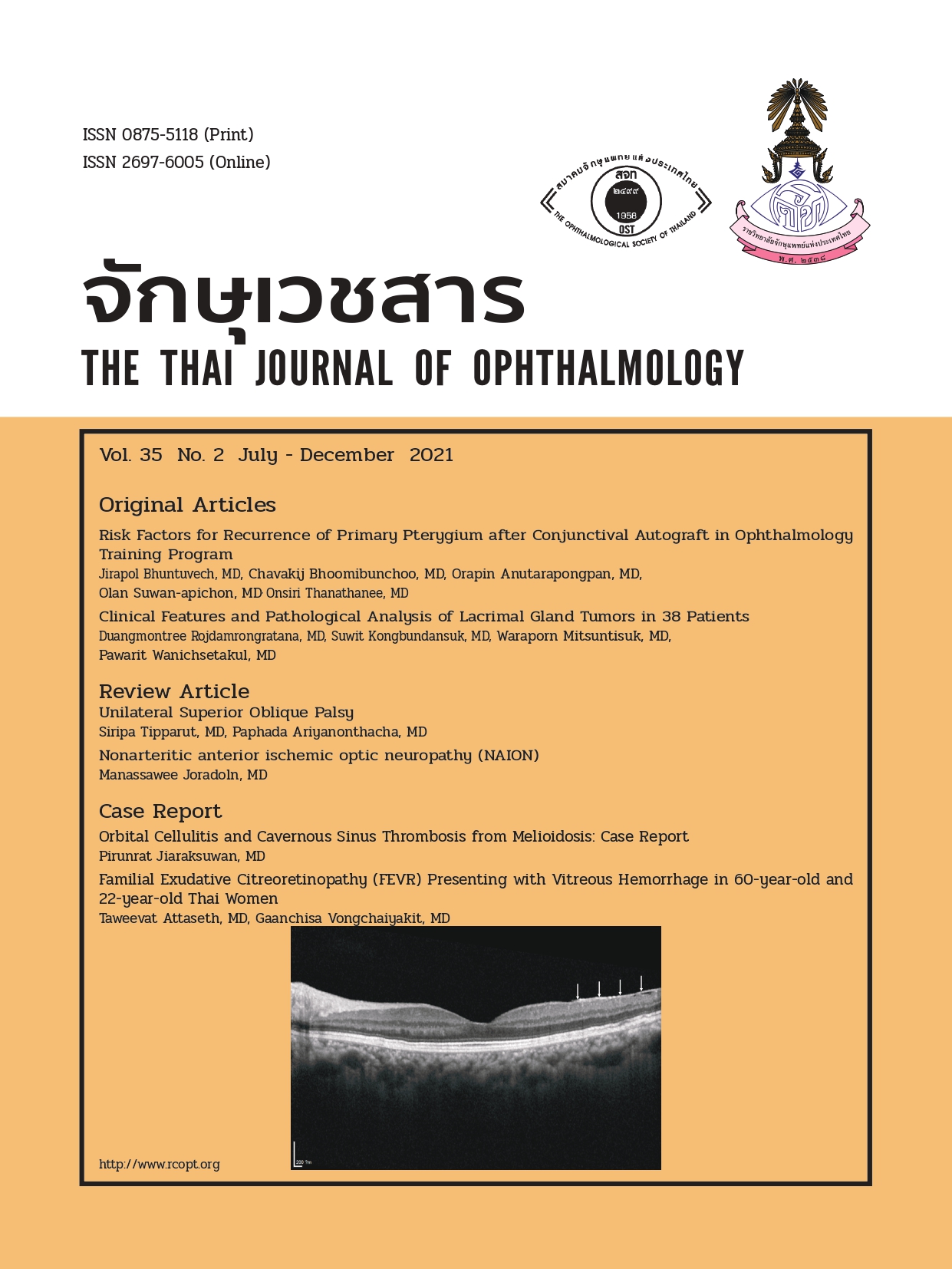Risk Factors for Recurrence of Primary Pterygium after Conjunctival Autograft in Ophthalmology Training Program
Keywords:
pterygium, recurrence, trainee, operation time, relative riskAbstract
Objectives: The purpose of this study was to determine the risk factors related to recurrence of pterygium after
surgical excision with conjunctival autograft for primary pterygium performed by ophthalmology trainees.
Methods: Fifty-eight eyes of 58 patients with primary pterygium were consecutively included in the prospective
observational study. The pterygia were preoperatively graded based on corneal involvement and translucency. Recurrence
rates and associated risk factors were evaluated at 1, 3, 6, 9 and 12 months postoperatively.
Results: Recurrences occurred in 8 out of 58 eyes (13.79%) and most cases were detected within 6 months.
The mean recurrence onset was 5 ± 4.2 weeks postoperatively. Operation time ranged from 30 to 120 minutes and the
average was 65.43 ± 21.01 minutes. Mean duration of postoperative topical corticosteroid was 6.48 ± 2.27 weeks.
The recurrence was not statistically significantly associated with age (P = 0.669), gender (P = 0.418), occupation
(P = 0.706), address (P = 0.462), pterygium translucency (P = 0.637), corneal involvement (P = 0.334), academic year
of ophthalmology trainees (P > 0.999) , duration of postoperative topical corticosteroid (P = 0.535) and operation time
(P = 0.139). Prolonged operation time, however, showed the highest relative risk (4.28).
Conclusions: The authors could not find significant risk factors associated with the recurrence of pterygium in
the training program. Prolonged operation time was more likely to relate with the recurrence of pterygium.
References
2. Nuzzi R, Tridico F. How to minimize pterygium recurrence rates: clinical perspectives. Clin Ophthalmol Auckl NZ 2018;12:2347-62.
3. Graue-Hernandez EO, Córdoba A, Jimenez-Corona A, et al. Practice Patterns in the Management of Primary Pterygium: A Survey Study. Cornea 2019;38:1339–44.
4. Chu WK, Choi HL, Bhat AK, et al. Pterygium: new insights. Eye Lond Engl 2020 Feb 6. doi: 10.1038/s41433-020-0786-3.
5. Arriola-Villalobos P, Cifuentes-Canorea P, Peraza- Nieves JE, et al. Fibrin glue conjunctival autograft for primary pterygium: Overall outcomes and outcomes in expert versus trainee ophthalmologists. J Fr Ophtalmol
2018;41:326-32.
6. Farrah JJ, Lee GA, Greenrod E, et al. Outcomes of autoconjunctival grafting for primary pterygia when performed by consultant compared with trainee ophthalmologists. Clin Experiment Ophthalmol 2006;34:857-60.
7. Kositphipat K, Tananuvat N, Choovuthayakorn J. Results of pterygium excision adjunct with conjunctival autograft transplantation for primary pterygium by ophthalmology trainees. Int Ophthalmol 2016;36:615-21.
8. Tan DT, Chee SP, Dear KB, et al. Effect of pterygium morphology on pterygium recurrence in a controlled trial comparing conjunctival autografting with bare sclera excision. Arch Ophthalmol 1997;115:1235-40.
9. Youngson RM. Recurrence of pterygium after excision. Br J Ophthalmol 1972;56:120-5.
10. Sheppard JD, Mansur A, Comstock TL, et al. An update on the surgical management of pterygium and the role of loteprednol etabonate ointment. Clin Ophthalmol Auckl NZ 2014;8:1105-18.
11. Chalioulias K, Dwarika D, Thakur S. Pterygium excision with conjunctival autograft: consultant versus trainee. Clin Experiment Ophthalmol 2007;35:396.
12. Ti SE, Chee SP, Dear KB, et al. Analysis of variation in success rates in conjunctival autografting for primary and recurrent pterygium. Br J Ophthalmol 2000;84:385-9.
13. Karalezli A, Kucukerdonmez C, Akova YA, et al. Fibrin glue versus sutures for conjunctival autografting in pterygium surgery: a prospective comparative study. Br J Ophthalmol 2008;92:1206-10.
14. Kheirkhah A, Casas V, Sheha H, et al. Role of conjunctival inflammation in surgical outcome after amniotic membrane transplantation with or without fibrin glue for pterygium. Cornea 2008;27:56-63.
15. Aidenloo NS, Motarjemizadeh Q, Heidarpanah M.Risk factors for pterygium recurrence after limbalconjunctival autografting: a retrospective, single-centre investigation. Jpn J Ophthalmol 2018;62:349-56.
16. Paris F dos S, de Farias CC, Melo GB, et al. Postoperative subconjunctival corticosteroid injection to prevent pterygium recurrence. Cornea 2008;27:406-10.
17. Romano V, Cruciani M, Conti L, et al. Fibrin glue versus sutures for conjunctival autografting in primary pterygium surgery. Cochrane Database Syst Rev 2016 Dec 2;12:CD011308.doi: 10.1002/14651858. CD011308.pub2.
Downloads
Published
Issue
Section
License
Copyright (c) 2021 Thai J Ophthalmol

This work is licensed under a Creative Commons Attribution-NonCommercial-NoDerivatives 4.0 International License.
The Thai Journal of Ophthalmology (TJO) is a peer-reviewed, scientific journal published biannually for the Royal College of Ophthalmologists of Thailand. The objectives of the journal is to provide up to date scientific knowledge in the field of ophthalmology, provide ophthalmologists with continuing education, promote cooperation, and sharing of opinion among readers.
The copyright of the published article belongs to the Thai Journal of Ophthalmology. However the content, ideas and the opinions in the article are from the author(s). The editorial board does not have to agree with the authors’ ideas and opinions.
The authors or readers may contact the editorial board via email at admin@rcopt.org.


